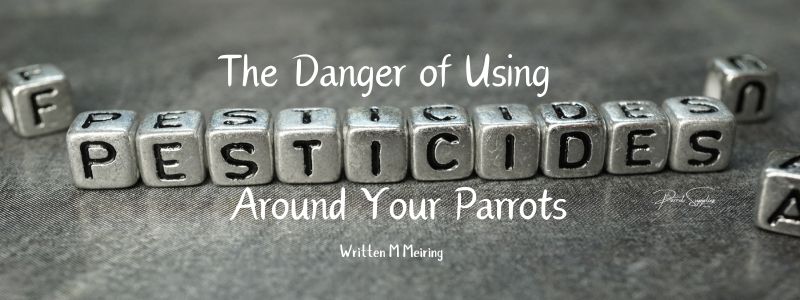The Danger of Using Pesticides Around Your Parrots
Parrots are curious. They chew, preen, and explore—often with their mouths or breathing in whatever’s in the air. That makes them highly sensitive to chemicals meant for pests. Insecticides, herbicides, rodenticides, and even pet flea treatments may be quietly dangerous. Let’s unpack the risks and how you can protect your feathered friends.
Why Parrots Are Especially Vulnerable
Parrots’ metabolism and respiratory systems differ significantly from mammals. Studies show birds process toxins more slowly due to less active metabolic enzymes—making them more likely to suffer from pesticide exposure than humans or other pets. PMC
Even “safer” chemicals like neonicotinoids (commonly used in flea, tick, and garden treatments) persist in the environment. They’re highly water-soluble and linger in soil—leading to both direct and indirect exposure to birds. Chicago Bird Alliance
Invisible Threats: Direct and Indirect Exposure
1. Direct poisoning at home
The ASPCA reported that—among pet bird poisoning cases—22 % involved pesticides, second only to medications. Even a short spray in the house can be hazardous. Birds Connect Seattle+12DVM 360+12thegabrielfoundation.org+12
Bird owners emphasize this in every forum and community. One owner spoke out:
“They [pest controllers] thought I knew they would be spraying... Why would I remove all aerosol deodorisers… and knowingly leave them in a room with pesticides? They could have killed them!” Parrot Forum Parrot Owners Community
2. Environmental and wildlife fallout
A startling 2025 study found high levels of fipronil and imidacloprid—both potent insecticides—in the fur birds used to line their nests from treated pets. Every nest sampled showed contamination, with more unhatched eggs and dead chicks in highly contaminated nests. thegabrielfoundation.org+12The Guardian+12The Guardian+12
As one expert said:
“No nest was free from insecticides in our study... this raises questions about the environmental impact of veterinary drugs.” The Guardian
A follow-up commentary reinforced the broader ecological toll:
“Pet owners want to help their pets—but these treatments can devastate wildlife.” The Guardian
3. Agricultural and landscape pesticide drift
Agricultural insecticide use has soared—estimates show over 67 million bird deaths annually in the U.S. alone, mostly due to insecticides present in 70 % of dead birds examined. Chicago Bird Alliance
Moreover, a wide variety of pesticides (not just insecticides) carry substantial toxic loads for birds. Studies in Great Britain found herbicides and fungicides—used in greater volume—contribute significantly to overall bird toxicity. ResearchGate+12PMC+12PMC+12
Even low-dose exposure can disrupt hormone systems, reproduction, and thyroid function in birds. Beyond Pesticides
Signs of Pesticide Poisoning in Parrots
Watch for these red flags:
-
Sudden lethargy, tremors, or seizures
-
Loss of coordination or paralysis
-
Breathing distress or coughing
-
Bloody or abnormal droppings
-
Burns or irritation around the mouth or skin DVM 360+3thegabrielfoundation.org+3American Bird Conservancy+3
If you suspect poisoning: remove the bird from the area, ventilate well, and contact your avian vet right away.
Safer Alternatives: Keep Your Bird Safe
** At Home:**
-
Never use aerosol sprays, foggers, or pesticides in a room with your bird—even after spraying; wait at least 24 hours and ensure full ventilation. thegabrielfoundation.orgBest Friends Animal Society
-
Use rat traps instead of poisons; avoid anticoagulant rodenticides which can cause secondary poisoning. Birds Connect Seattle
-
Switch to natural homemade cleaners—like vinegar and water, lemon oil polish—safer and non-toxic. Parrot Forum Parrot Owners Community
** In the Garden or Yard:**
-
Avoid herbicides and insecticides entirely near aviaries or windows—manual weeding and planting native vegetation are safer alternatives. Birds Connect Seattle
-
Be cautious with systemic treatments—like neonicotinoids. Their persistence means even treated plants can harm birds long afterward. Chicago Bird Alliance
Pet Flea Treatments:
-
Consider non-chemical or herbal options that don’t carry systemic pesticides harmful to avian life. The Guardian
-
If you must treat pets: do so away from outdoor aviaries, and avoid letting treated pets shed fur into bird spaces.
Ecological Responsibility: Pets and Wildlife Coexistence
We care deeply for our parrots. That same care should extend to the ecosystems they’re part of. One concerned reader said in response to recent studies on pesticide contamination in nests:
“I may have imagined the tone... but I have bought some herbal flea repellent… we will see how it goes.” The Guardian+2Best Friends Animal Society+2The Guardian
Every small choice—like avoiding harmful products—adds up. It’s not just about family safety; it's about preserving biodiversity and supporting our feathered wildlife neighbours too.
Quick Safety Checklist
| Area | Safe Alternatives |
|---|---|
| Home | Natural cleaning solutions, no aerosols, dog-proofing around birds |
| Garden | Manual weed control, avoid chemical sprays or drifts |
| Pets | Herbal flea treatments, kept away from birds post-treatment |
| Monitoring | Watch for symptoms and always have your avian vet’s number handy |
Final Thoughts
Pesticides may target bugs or rodents—but they pose serious, often underestimated risks to parrots and birdlife. But we can break that link.
By opting for non-toxic alternatives, being mindful around your bird’s living area, and choosing safer treatments for other pets, we create a healthier environment for every winged friend in and around our homes.

